|
[ Back ] [ Home ] [ Up ] [ Next ]
[ Guatemala City & Antigua Lodging,
Restaurant & Medical Recommendations ]
|
Click any picture to
enlarge; then close out of that window to return here.
There are 2 SLIDE
SHOWS and 1 MOVIE VIDEO so be sure to look at them. |
|
GUATEMALA
Part 2: Guatemala City, Antigua
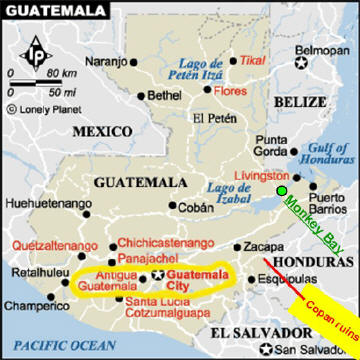
|
|
|
|
|
|
GUATEMALA CITY:
After a week of settling in at
Monkey Bay, we head to Guatemala City (for dental issues) on a 6-hour
"luxury" bus ride winding through the mountains (US$6.70). They do
show movies, usually of some Guatemalan Jerry Lewis-type character with a
quirky mustache; once a B&W Mexican western musical. Guat City, or
"the City", as it's known locally, is the largest city in Central America.
As with any big city, and we envision this to be similar to Caracas, it is
known for not being a safe place in general. However, as with any big
city, there are always safer areas and common sense precautions to be taken.
Based on recommendations from cruisers, we stay in Zona 10, also known as
Zona Viva, with its luxury hotels, gourmet restaurants, trendy bars and
nightclubs and first class shops and malls. This is probably the
safest area in the city, with well-armed security highly visible at most
doorways or inside, and up and down all the streets at all hours. We
walk the area day or night, and adjoining zonas during the day without worry
or problems. We stay at a "guest house" located in the center of Zona
10, which offers clean rooms, albeit not fashionably decorated, with private
bath/hot electric shower (see sidebar), cable TV, refrig and phone, and free internet and ice
-- all for the cruiser's discount of US$25 / night! In Guat City you
can't beat the price for this prime location. (See
Guatemala City & Antigua Lodging,
Restaurant & Medical Recommendations
for Guatemala City and Antigua.)
Many Americans adopt Guatemalan children
as evidenced by the many happy couples pushing strollers with dark
complexioned infants; in fact, one of the Zona 10 hospitals has a whole
floor dedicated just for this purpose. A recent local article says
that 23,000 children have been adopted by Americans over the past 10 years
bringing in millions of dollars into the Guatemalan economy.
Guat City's elevation
is 4,500 ft. offering rather pleasant daytime temperatures but cooling at
night for long sleeves. It was a welcome relief from the heat and
humidity of the Rio. A few days in the city gave us a chance to check
out recommended restaurants and the shopping for future reference, not to
mention the dental specialists (yeh, they speak English, were trained in the
U.S. and are every bit as competent as in the U.S.). We also checked
out a few museums, of particular interest the Museo Ixchel of Mayan
textiles, the traditional art of the Guatemalan highlands. Deborah's
good friend in Houston has been weaving (on foot-treadle looms) for years and last year
studied with the local women in Guatemala's highland villages, thus Deb's
special interest. This museum gave us a good knowledge base.
Since then we have
been back to Guat City a few more times. One trip we did our annual
physicals using English-speaking doctors recommended by other cruisers.
(See
Guatemala City & Antigua Lodging, Restaurant & Medical Recommendations.) We were impressed again with
the quality and thoroughness of service and state-of-the-art equipment.
It certainly was cheaper than doing it in the U.S., but still nothing beats
Venezuela for low cost and very high quality.
For serious shopping or
that hard-to-find item, Guat City is the place. See the handy listing
Guatemala City
Recommendations from Monkey Bay Cruisers
which includes useful shopping, services,
entertainment, lodging, medical, transportation, etc., information.
|
|
FINDING your WAY
around GUATEMALA is
easy. Most cities follow a logical grid pattern, with
avenidas (avenues) running north-south, sequentially numbered
starting with 1 from the west; calles (streets) run west-east
sequentially numbered starting with 1 from the north. Then
along each avenue or street, each building is numbered sequentially,
with odd numbered buildings on one side and even on the other. To
avoid the problem of where building #30 may be on a different block from
#31, the cross road is also used.
In addition, most
cities are divided into Zonas - Guatemala City has 21 zones -
with each zone having the same numbering system. Thus, you must
know the zone number as the exact same avenue/street address could exist
in 21 different places in the city!
For example, a
favorite restaurant is located at 2a Av 13-25, Zona 10. Thus, its
in zone 10, building #25 on 2nd Avenue just after 13th street.
|
|
The ELECTRIC
SHOWER. Uh-huh. The typical hot shower in Guatemala is this electric
contraption
 that
heats water "on demand" when the shower is turned on. Note the
wiring job. There is a switch that selects off-warm-hot, but don't
touch it with the shower running. It took me 2 times to learn that
lesson - zzzzzzz. that
heats water "on demand" when the shower is turned on. Note the
wiring job. There is a switch that selects off-warm-hot, but don't
touch it with the shower running. It took me 2 times to learn that
lesson - zzzzzzz. |
|
|
|
|
|
ANTIGUA GUATEMALA
(it's official name):
A 45-minute US$10 door-to-door shuttle van trip (it's safer than the $1
chicken bus) west puts us in the small city of Antigua, one
of the oldest and prettiest cities in the Americas. It was the Spanish
colonial capital of Guatemala from 1543 until numerous earthquakes finally destroyed
it in 1773 (when the capital was transferred to present day Guatemala City).
During it's heyday, no expense was spared on opulent architecture which
included 38 churches (monasteries and convents, too) and a cathedral - a lot
for a city not that big.
Today, Antigua retains its charm with its cobblestone
streets, crumbling ruins supporting new structures, and brightly painted
facades, most which innocently conceal alluring gardens and atriums behind
their tall walls and thick speak-easy-type wood doors - much like New
Orleans' French Quarter. A peak into a nondescript open doorway
usually makes for a visual treat. The city is at 4,500 ft.
elevation with welcomingly pleasant temperatures and surrounded by mountains
and 3 majestic volcanoes, which can be seen spewing smoke/steam occasionally.
We were amazed at all
the young single people here, many of them on summer break from college and
others backpacking through Central America, many attending Spanish school.
But what was even more surprising was that the majority of these young
people were traveling alone, and of those more than half were girls!
Obviously they're not afraid traveling here. The main stories we heard
concerning safety were of cameras being stolen (with all their trip
pictures in it). We travel with a 1 GB memory stick (and
multiple camera cards) so we can occasionally dump our pictures off the
camera cards - internet cafes are plentiful. We can replace our camera
but not our pictures.
This is rainy season,
which they call winter. We wore shorts and t-shirts during the day
(high 60's - 70's), very pleasant. But the locals are wearing wool
sweaters, jackets and knit hats and can't understand, again, us crazy
gringos!
As the electricity in
Guatemala in general is unreliable (Monkey Bay has its own big generator so
we don't really notice) we travel with flashlight, candle and lighter - and
have used them several times. Unfortunately we can't do much about
loss of water service, which happened frequently during the night,
apparently due to water line repairs.
A quick bus ride into
neighboring Jocotenango took a group of us to a nice spa where we had hour
massages and steam for Q55 (US$7.30).
|
|
FINDING your WAY
around ANTIGUA is similar using avenues and
street designations also, but due to the small size there are no zones.
At the center of the city is the obligatory Central Park, and all
buildings start numbering sequentially starting at the park with #1,
referencing their location with respect to the park. For
example, 7a Ave. Norte 29, indicates it's building #29 on 7th avenue
north of the park. |
|
|
|
|
|
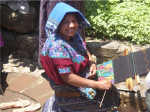
Backstrap looms; making huipiles
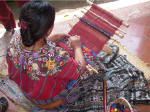
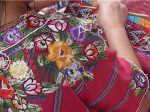
Close up of huipil decoration
|
"So, why
doesn't her blouse match her skirt?" 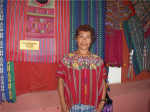 This drove me nuts
the first few times I saw Maya women in traditional dress. "Surely
she has something in, say blue, that would go."
The answer is in
tradition, and the huipil is like a uniform worn proudly
everyday. Skirts are also of tradition and village specific but to
a lesser degree. |
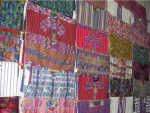
Used huipiles hang on racks
for display and purchase
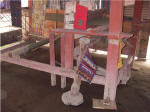
Large, rustic foot-treadle loom used
traditionally by men only |
WEAVING,
embroidery and other textile arts are practiced by the Mayan people in a
traditional manner for both everyday use and to sell. Their
typically brightly colored and intricately made trajes (traditional
clothing) are beautiful pieces of art, painstakingly made, and worn by many
women whether in the city or village; men are more prone to Western wear
(no, not C&W). Each Mayan pueblo, or village, has their own
designs, colors and techniques, so it is easy to identify a person's origin
- this was originally devised by Spanish colonists to distinguish one
village from another. It is estimated there may be 500 different
clothing (each village).
The most treasured piece of Mayan clothing
is the woman's huipil (pronounced wee-peel), a sleeveless tunic top
bearing her village's design, color and technique. Depending on
complexity, it may take a woman 8 months to make one huipil (while
tending to her other duties), maybe more for a ceremonial huipil.
Women make them using a backstrap loom - one end tied to a fixed object, the
other end secured around her back side for tension. The huipil that a
Maya woman wears conveys information such as her birthplace, religious
background, social position, weaving skill and personality - the ultimate
expression of her identity as a woman and individual in her community
- which can be read at a glance by others.
Women also typically wear cortes, wrap-around
skirts, which are usually 2 to 10 yards of cloth. The corte
material is made by men using a big foot-treadle loom (women do not use
these big looms), which then may be
embellished with embroidery or appliqués by women. (See sidebar below
for more clothing descriptions.)
To get educated on Guatemalan
textiles we visited the Museo Ixchel (Guat City) and Casa del Tejido Antiguo
in Antigua. Also in Antigua is a huge indoor market called Nim Po't
that sells used huipiles and other clothing and art.
Huipiles are displayed on racks organized by village, so they are easy
to peruse.
We have only begun to see the vast
woven textiles of Guatemala. On a future trip we will venture into the
Highlands, Lake Atitlan (Panajachel) and Chichicastenango - this area is where a high
percentage of the indigenous Maya people live, who maintain their traditional
customs and costumes - where we will be able to shop weavings at the
"source". So we'll have more to report later on.
If you
are at all interested in textiles and weavings, or just want to see some
better pictures, you need to check out
www.nimpot.com - it is an EXCELLENT website. It's
arranged by Textile and by Pueblo, with descriptions, pictures, and items
for sale. Be sure
to look at the traditional huipiles. Quilters will enjoy the
Textile section on Quilts. As far as Pueblos, these are some good ones
to look at: San Antonio A.C., Aguacatan, Chichicastenango and Santa
Catarina.
Please see
Guatemalan Textiles Bought and on that
page
Parts of a Backstrap Loom used in Mayan Weaving for additional
information on this subject.
|
CASA DEL TEJIDO ANTIGUO
(museum, market and workshop)
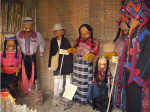
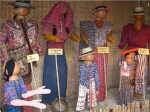
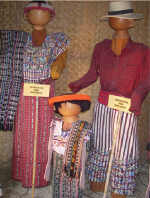
The above museum scenes shows
traditional trajes for specific villages. Note how the family
members clothing are "coordinated"
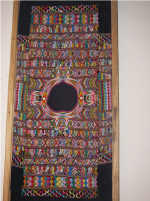
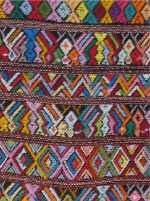
Displayed huipil "opened
up" - center hole for head; close up of same showing detail
|
|
TRADITIONAL
MAYA CLOTHING COMMONLY SEEN |
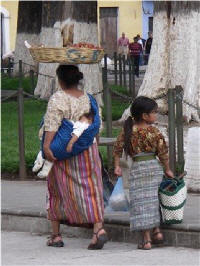 |
|
traje - traditional
indigenous Maya clothing; village specific and usually brightly colored |
|
huipil
- woman's colorful and intricately hand-woven sleeveless tunic or blouse
worn by women to indicate their birth village, social position, weaving
skill, etc.; hand-made by women using backstrap looms |
|
tocoyal - woman's
woven head-covering made from very long, twisted bands of cloth and may
be elaborately decorated with tassels, pom-poms, silver ornaments, or
intertwined with their long hair |
|
corte - woman's
wrap-around skirt made from 2 to 10 yards of fabric; material
made on large foot-treadle looms by men |
|
fajas - backstrap-loom-woven
sash worn by men and women around waist as a belt; folded with opening
up serves as pockets |
|
tzut or kaperraj
- long and wide all-purpose cloths used as baby slings, shopping bags,
carrier for peddling textiles, basket cover, shawl, head covering and
head cushion for carrying things on their head; they are worn around
neck/shoulder/waist and carried on front, side or back. |
|
shoes - typically Western shoes
(leather sandals) or barefoot |
|
|
|
|
|
|
SPANISH
LANGUAGE SCHOOLS. Antigua is widely known for it's Spanish language
immersion schools (about 75 schools are located here). After
"shopping" schools we decided on
Casa de Lenguas Guatemala
and attended for 2 weeks with one-on-one private instruction. Typical
schedule is 4 hours every morning Monday thru Friday, so this leaves the
afternoons free for school activities and studying. This particular school
structures it where you have one instructor for 2 hours then another for the
next 2 hours. You keep these 2 instructors all week, and they coordinate
between themselves. The next week you get 2 new instructors. We
enjoyed our teachers, the school and activities very much and may go back for more later in
our stay.
|
TORTILLAS.
Did you know that the average Guatemaltecan woman makes 125 tortillas
a day? |
The school activities ranged from
free stuff to cheap afternoon field trips to weekend trips (which we will do
on our own later on), focusing on teaching us about the Guatemalan culture. We took a walking tour
of Antigua, salsa dance lessons, learned about the
Catholic Antiguan holiday Corpus Christi and made/ate traditional food and took a
bike ride through the countryside to sightsee villages and churches (and got drenched on the way back,
crossing a street-now-turned-river from the flash flood).
One field trip was to a remote Maya village, Santiago San Morro, where the women
entertained us in their thatched-roof dirt-floor houses. We made tortillas
(no chimney so the room got very smokey), learned
about traditional Mayan weaving (Deb got to strap on the back-strap loom and do a few
stitches), toured their
humble village and lush "farm" fields. The highlight of our visit was a huge
meal of the traditional dish
pépian - a piquant sesame and pumpkin seed soup
to which you add chicken, root vegetables and rice. We were also served hot
tortillas and special tea. Excellent.
While at Spanish
school, we stayed with a local family for a week. Another female
student from our school, Fely from Paris, had been living there for a couple of months. The
family was headed up by Lady Chata, a widow, and included her son and his
wife and 2 small girls, an uncle, a good family friend and a few other
people that we think were related who'd come and go. Either the deceased
husband or uncle was a doctor, so this house is considered very nice.
Through the big garage-sized wood front doors you enter into a U-shaped house with
grass and gardens. As is customary for wealthier Guatemaltecos, cars
are brought in through the front doors and parked on the grass or patio each
night for security reasons. Sometimes there would be 4 cars in there.
It was pretty hysterical, the English-speaking jovial uncle had his "spot"
and would meticulously bring in his car (it was missing a window) and turn
it around. The problem was that it kept dying as he maneuvered, and
was VERY LOUD as he'd fire the thing up and let it idle for a while - right in front of our door.
But he loved that car. Our rooms, and shared bath, were on one "wing"; the kitchen and dining room
were on the other "wing"; and the family bedrooms, baths, and living area
between the 2 "wings". It's open air in that you walk outside, but
under cover, to go between rooms.
For about US$80/person/week, we got
lodging and 3 meals a day, except on Sundays. We had been warned that
with many families you eat nothing but beans, rice and tortillas, so we were
prepared to lose some weight. But we lucked out and Chata was a great cook, serving tasty,
healthy meals with good variety. Tortillas were always served, but we
only had beans once! We muddled through conversations in Spanish, but
did resort to English with Fely when we really wanted to
communicate. It was odd as Chata was usually the only one who ate with
us, sometimes her son or daughter-in-law - others seemed to take food to
their rooms - but they almost always ate only
beans, rice and tortillas. We surmised that this was a combination of
tradition and of cost. Chata made the traditional dish
pépian for us, and she makes
tamales to sell on Saturdays, which were quite good, also.
|
| |
|
VOLCANO
PACAYA:
Besides the 3 volcanoes rimming
Antigua, there are several other volcanoes near by. Perhaps the most
popular to climb in Guatemala is Volcano Pacaya, 8,400 ft. elevation, a 2-hour bus ride from Antigua. Pacaya is considered highly active and has been in constant eruption since
1965 - blowing off steam, occasionally sending magma bombs 8 miles out and lava flows
necessitating the evacuation of numerous villages on her flank. Tour
operators (US$12 /person/all inclusive) keep a pulse on her status and
provide security, so off we went for a day rip.
We could have ridden horses up to the
top (nobody did), but being a generation older than these young
backpacker-types we rallied for the 1.5 hour climb up the well-maintained dirt trails.
This brought us to the base of the cone and at the rim of the old crater.
From there, we could see steam and red-glowing spots across the crater and
cone. Status was such that most tour operators were going down
into this crater. There is a sign posted saying that going beyond it is at
your own risk of toxic sulfur gas, lava flows and eruptions - causing
possible death. Hmmm. We've come this far, and as there are a
bunch of people walking across the lava, we venture out. "Yikes, this
stuff is hot - and I'm suppose to walk across this?!" Yep, there are
small active vents all over emitting very hot gas, and although the lava was
solid in some places, it was very brittle and crunchy in other spots.
As I was the most "mature" woman out there, and a bit uneasy with the
footing possibilities, a local guide took me under his wing (we gave him a
small tip at the end) and led us across the lava and around the risky
spots. That was fine with me. Steve saw a guy fall through some
thin crusty lava, fortunately there was no sizzling lava flowing underneath,
but his legs and arms got pretty cut up, as hardened lava is very, very sharp.
Further out, the exposed lava rivers got so hot that people with bare legs
came back with bad "sun burns" - we were in shorts so didn't go there - and
2 girls showed us holes in their Keds shoes that had melted through.
Yikes . . . again. It was a memorable experience. A few weeks
ago
in the paper we see that lava rivers have suddenly started flowing and
villages were put on notice to evacuate, but as of this week, the alert was
off as lava was being diverted through a large "crack" on the side of the
cone.
In the slide show pictures, the
brown lava is solid, albeit brittle in places. Underneath runs the
rivers of red-hot lava, sometimes reaching the surface and also visible
where our guide broke through. He stabbed the hot lava with a stick
which caught fire - kind of like playing in a campfire.
There are also tours that go at night
and sound awesome; however, there's no way I'd walk across that precarious lava in the
dark! For some great aerial shots, try
http://volcano.und.edu/vwdocs/current_volcs/pacaya/pacaya.html.
|
|
 |
|
View
MOVIE VIDEO of
Volcano Pacaya
(you probably need
Windows Media Player to view) |
|
 |
|
This is truly
amateur quality, first attempt ever at it, but look anyway.
The background audio is mostly wind . . . or lava crunching. Hope
you don't get motion sickness easily . . . |
| |
|
|
|
|
MACADAMIA NUT FARM
We met an ex-cruiser who now lives in Antigua and went with her to the Valhalla
Experimental Station, an organic macadamia nut farm. Macadamia trees were first
discovered in Australia, taken to Hawaii and then to California where
avocado growers tried to grow them but the trees did not do well in that
climate. Seeds from the hardiest were cultivated and eventually the
avocado growers brought them to Guatemala where they grow quite well.
This farm has been improving genetic varieties for over 20 years resulting
in strong trees with high production. They now boast over 300 species
(experts disputed this until they came and witnessed it for themselves) and
have planted over 250,000 trees. Because of the wide variety of
species, there are always trees producing nuts throughout the year.
We were given a tour and then served
breakfast of macadamia nut pancakes with macadamia nut butter, local honey,
blueberries and bananas, and hibiscus tea. We sampled chocolates made
from the nuts, and tried the cosmetic beauty oils and creams - they are
really nice as they quickly and completely absorb into the skin, sealing in
moisture, leaving the skin really smooth - and it smells really good, too.
We learned that the farm's purpose is
manifold. Macadamia nut trees:
1) Give the poor indigenous farmer
jobs, an economically reliable crop, an alternative to coffee which
is unstable and environmentally harmful. The soil remains stable so
crops do not have to be rotated around. Valhalla volunteers go around
planting trees in outlying communities and worldwide.
2) Provide reforestation which is desperately needed in Guatemala to
save the tropical forests and help keep the land from eroding into land- and
mudslides, etc. Pine trees are typically used for reforestation, but
macadamia is better.
3) Promote a healthy environment
by taking large amounts of carbon dioxide out of the atmosphere and
returning it to the soil, putting large amounts of moisture back into the
air and providing wide areas of shade for temperature control and to allow
other plants to grown underneath it. They grow 60 ft. high and 40 ft.
wide.
4) Are low/no maintenance,
requiring watering the first year or two, then after that they are self
sufficient and do not require fertilizing, watering, etc. They can
grow in all temperatures and soil conditions except freezing and all-sand.
Because of the extremely hard outer shell, the only natural pest of the
macadamia is the rat that can use it's front teeth to penetrate the shell.
They do put rat poison out to keep them away.
5) Provide food source, with
many important nutrients.
If you
want to know still more, visit
www.exvalhalla.net. |
|
|
|
|
EARTH LODGE,
located in the mountains above Antigua and overlooking Jocotenango, is a
funky, very laid-back avocado farm & backpackers' retreat owned by Canadians
and currently "managed" by an Israel guy. We went up for the day, had
lunch and hung out (not much else to do there). Accommodations include
a tree house with spectacular view, A-frame cottages and a dormitory.
Rustic but nice toilet and shower facilities, and a stone steam "room".
A guy from San Salvador?, who had been there a few months made jewelry,
including some nice bone carvings on decorative cording which we bought
among a few other little things.
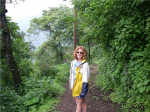 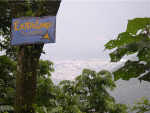 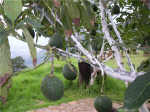  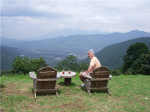 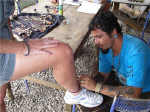 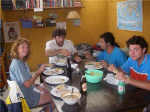 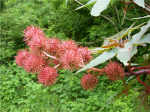 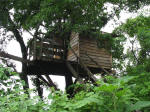
(cursor over picture for
description)
Earth Lodge's posted price list on the
wall included (Q1 = US$0.13):
| Cerveza
(beer) |
Q12 |
| Pork
Chop |
Q14 |
| Shower |
Q8 |
| Condom
|
Q8 |
Everything one could need.
|
|
|
|
Guatemala continued . .
. |
|
[ Back ] [ Home ] [ Up ] [ Next ]
[ Guatemala City & Antigua Lodging,
Restaurant & Medical Recommendations ] [ Top of page ]
|
![]()